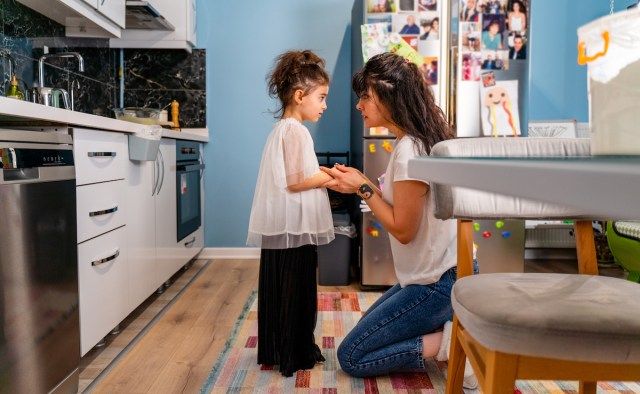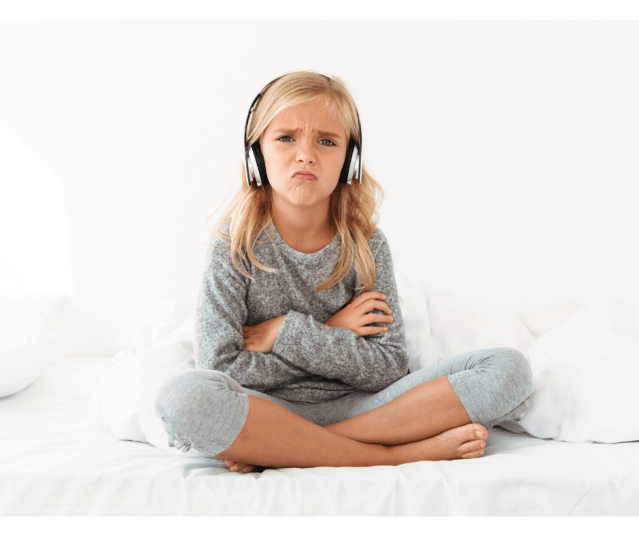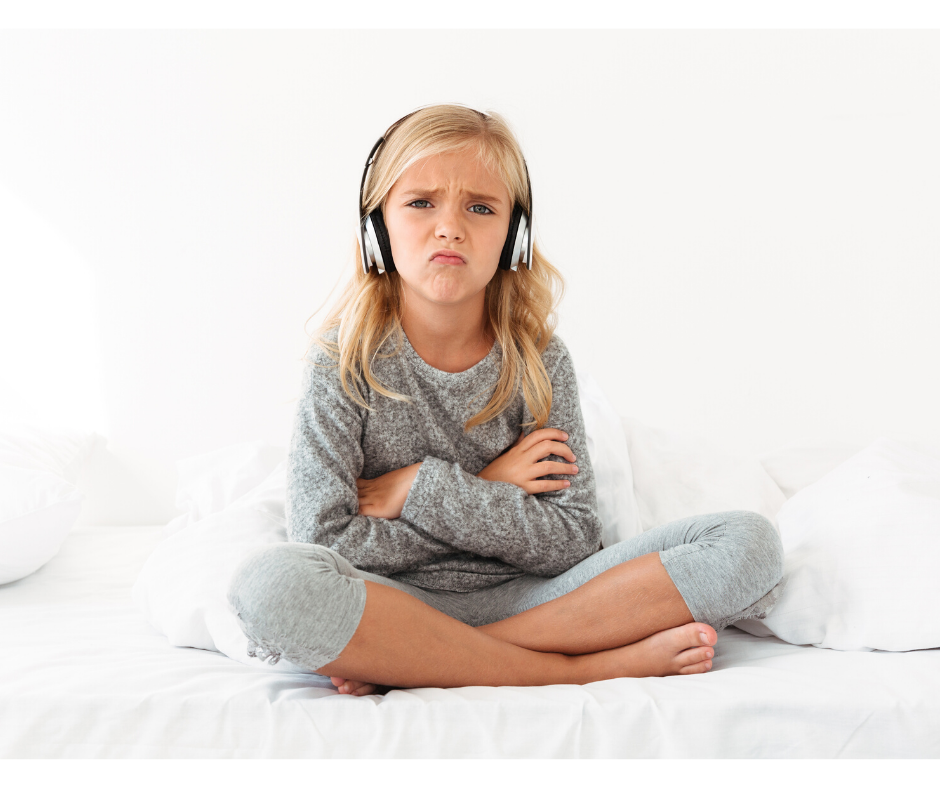Let’s be honest, almost everyone yells at their kids sometimes. Just picture your average busy morning trying to get everyone out the door: One of them starts whining or picks a fight with their sibling and you’re about to be late, again. You feel your frustration beginning to bubble up and before you know it, you’re shouting at everyone because you just need to GET OUT THE DAMN DOOR! Someone (maybe you) starts to cry and then everyone starts their day feeling terrible.
While it’s totally normal to blow your top occasionally, studies show that it’s not a very effective parenting strategy, it doesn’t help your kids behave any better, and it can lead to loads of negative outcomes in the future (behavioral and emotional, among others). But even if you know that yelling is bad, how do you break the habit?
“There are very few people who do not yell,” says Dr. Michele Locke, a registered clinical psychologist specializing in child, adolescent, and parenting psychology in Toronto. “Most people do.” But that doesn’t mean you can’t improve your relationship with your littles. Here are some simple steps to help you stop yelling at your kids and get a handle on your behavior.
1. Consider How You Were Raised
How you behave has a lot to do with how you were treated as a kid yourself. “One of the main reasons that we yell is that we were raised in that kind of environment,” says Dajana Yoakley, a peaceful parenting coach in Little Rock, Arkansas.
If you come from a family of yellers, it can feel ingrained in you to react that same way, explains Locke. For example, when you were a child and had a big emotion, like anger, if the adults responsible for you yelled at you during your outburst, you learned that your big emotions led to a negative outcome in someone that you loved.
“When you become a parent and your kids have those same emotions that you had as a kid, your reaction is habitual, because you’re actually trying to shut down the emotion almost like you’re reacting to your own little self,” says Locke. Hence the yelling.
But that doesn’t mean you can’t change. Understanding why you react that way is half the battle, and the other half is practice. If you can’t get there through parenting books, podcasts, or practice, which can be a tall order for a busy parent, therapy is another great option.
2. Know Your Triggers
“Parents yell because they are burnt out, exhausted, or triggered,” says Locke. Parents are most likely to yell before bedtime, when they’re rushed or overstimulated, or when their child activates a feeling in them that they can’t regulate, she explains.
Notice how your body feels in the moment right before you yell, during the yell, or right after, recommends Yoakley. Maybe your heart is racing, or you start to sweat. “You have to really tune into your body as an instrument to tell you the clues of what you’re feeling. If you don’t know what you’re feeling, then you can’t change what you’re feeling,” says Yoakley.
Once you start to recognize the feeling that you’re about to blow up, you can start to get a handle on it. There are also a few other things you can do to dial down your rage in the moment. If possible, remove the immediate stressor. Late for dinner? Takeout (or cereal) it is. Your kid doesn’t want to wear rain boots? Throw them in their backpack instead. If everyone’s hungry and tired, throw some snacks at the situation, which can regulate everyone’s blood sugar and take things down a notch.
3. Anchor Yourself
If you’re getting overwhelmed, and feel a yell building, try and remove yourself from the situation, or take a pause before you react. If you can safely leave your children for a moment, Locke recommends heading to the bathroom and putting an ice pack on your skin, or taking a few deep breaths to remind your body that it’s not an emergency. Breathing techniques, like the five-finger breathing technique, can help bring some calm, plus you can teach it to and model it for your kids. This mindfulness technique can help you find that mind-body connection, with no props required.
The key is really to stop yourself before you fall into the same pattern of overreaction. Let your kids misbehave for a few minutes longer so you can be ready to approach them calmly and lead by example. “Do whatever you have to do to anchor yourself in the moment and ask yourself, how do I move into this situation and be a sturdy leader?” says Locke.
4. Recognize the Vicious Cycle
“Shouting can work in the moment, but what happens long term is your child begins to shout too, and the relationship becomes more disconnected and ruptured,” says Yoakley.
The reason it might feel like yelling works to stop the bad behavior is because it’s scary and activates your kids’ fear response, says Locke. “It doesn’t teach them anything about what to do next time,” she says. “You just have to increase the intensity and frequency of your yelling.”
Related: 8 Phrases to Bring a Toddler Back From the Brink
Plus, your child learns that shouting is the only way that someone will listen to them. “You’re trying to get them to stop yelling by doing the same thing,” says Locke. Yelling is bad for kids for a variety of reasons. It’s associated with depressive symptoms and can put them at risk of developing lasting mental health problems. Harsh parenting practices can even change your child’s brain structure. Yikes!
But not yelling doesn’t mean you can’t help your children manage their behavior. “A sturdy tone is different than a yell,” says Locke.
5. Practice Self-Compassion
After you yell, notice how you talk to yourself. Instead of saying “I’m such a horrible parent and my kids are the worst,” or “I’m sure other people never have this problem,” try and offer the same kindness you would to a friend, says Yoakley. Tell yourself, “This is so hard right now,” and validate how you feel. When you validate your own anger or shame, it takes away some of its intensity, says Yoakley.
6. Repair, Repair, Repair
“Everyone’s going to yell at their kids sometimes,” says Locke. “The most important thing is what you do after the fact.” Repair is critical after a yelling match. What does repair mean? It’s more than just an apology, says Yoakley. Once everyone is feeling calm, have a conversation with your kids and take responsibility for how you behaved.
Locke provides a sample script of how to talk to your kids after a big shoutfest. “I got overwhelmed. My frustration came out as yelling and here I am, trying to have kids who don’t yell so I’m really working on that. And I’m sorry that it came out that way.”
Explain to your kids, even if they’re really small, that it’s something you’re working on and that it’s a “you” problem, not a “them” problem, says Locke.
“It’s important to tell your kids that it’s never okay for you to yell at them. Even if you were angry,” says Yoakley. Ask them how the fight made them feel. Did it make them feel sad, or scared? Let them express their feelings and wrap up the repair with a hug.
This viral Ted Talk by Dr. Becky Kennedy has more details on how to repair with your kids.
7. Quit Yelling About The Small Stuff
It’s pretty easy to get into a shouting routine and use it to get your kids to listen. Many parents yell at their kids when they’re not paying attention, when they spill their water (again!), or when they just won’t do the thing you’ve asked. While it’s one thing to occasionally yell when your kids misbehave, it’s another behavior altogether when you use it consistently. Your kids are more likely to tune you out, and you’re more likely to feel even worse about yourself.
Related: 9 ‘Harmless’ Phrases That Hurt Kids More Than You Think
If you know you’re going to blow on occasion, like when your kids decide it’s WrestleMania time, try and dial back your regular, everyday shouting. Instead of yelling up the stairs that “Dinner is on the table NOW,” calmly walk closer to them and announce that it’s time to eat. Or if you sense a shouting match coming with a kid who doesn’t want to clean up their toys, try completely flipping the script and using the “whisper technique.”
8. Set Yourself Up for Success
If you find you just can’t get on top of things, it’s time to get proactive. Is the morning rush always a huge trigger? What can you do the night before to make it easier and prevent a situation where you end up yelling? Set expectations for your kids and yourself. Ask them to pick out their clothes the night before. If breakfast is always a disaster, simplify what you offer. If you can, Locke recommends getting up earlier than your kids so that you have a few moments to yourself before the chaos begins. You can use a reward chart with before-school tasks if the morning is really dragging, but kids should get the hang of things if you have clear and consistent expectations and you don’t ask them to do too many things at once. Whatever event usually causes the most issues, ask yourself what you can do to get through those stressful moments more smoothly.
9. Keep Working On It
Two things can be true, says Yoakley. You can yell and be a good parent. The more you practice remaining calm and controlling the shouting, over time you’ll likely yell less, and your kids will cooperate more.
“As long as you keep trying, that’s more important than never yelling,” says Locke. “I think when we shame parents, it actually makes them less able to change.”

































